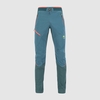Adam Ondra, the 100 x 9a or harder interview

 1 / 37
1 / 37 Petr Pavlicek
Petr Pavlicek
Ondra's 9a quest started back in 2006 when, as a mere 13-year-old, he sent Martin Krpan at Slovenia's Misja Pec and since then he has proven his worth not just in his home country, the Czech Republic, but all over the world. And – interestingly - on all types of terrain, from massively steep stamina plods to heinously explosive, short and bouldery testpieces. And also in all styles, namely redpointing existing lines, onsighting the utmost difficulties and making the first ascents of his own new routes. For the record, the world's three hardest routes have all been freed by him, and although Ondra failed to clinch the coveted world's first 9a onsight (despite having onsighted more than fifteen 8c's and downgraded some ex-9a's in the process) he set the record straight by onsighting three 9a's in the meantime. It's worth remembering that in all this, Ondra has also excelled in bouldering (up to 8C+, the absolute max), on multi-pitches (the first one-day repeat of Silbergeier, and first free ascent of both Wogü and Tough Enough spring to mind) and in competitions (in 2009 he won the Lead World Cup, a year later he won the Bouldering World Cup, while this season he won both the Bouldering and Lead World Championship). In short, Ondra's track record is second-to-none and needs no further explaining. One hundred 9a's or more are testament to Ondra's tremendous talent, refined technique, brute strength and enormous willpower that have paved the way from the past towards the future. To a century that must be celebrated.
One hundred 9a’s… we’re stunned. But what does this represent to you?
The number seems unbelievable! Even today 9a represents a really high level of difficulty, where I have to try hard. The fact that I’ve climbed so many 9a's already must be because I have been climbing at that level for a long time, even though I can remember the first 9a as if it were yesterday, Martin Krpan at Misja Pec, aged 13.
Of all the routes you’ve climbed in the meantime, which have provided you with the best moments and why? And which with the worst?
There were so many nice moments that I really can't pick out the ones which were the most emotional. They could be my hardest first ascents like Change or La Dura Dura, simply because I waited for the moment when I finally sent the route for such a long time. And also because I put a lot of effort into them. But apart from the hardest ones, I also have other good memories, such as the first ascent of Climb for Life 9a in Sicily, or repeating all the Alexander Huber classics such as Om or Weisse Rose. Because all of these are truly fascinating routes.
I can't really think of any bad experiences. We all climb because we love it, don't we? And even though the process of sending certain routes might be difficult or even frustrating, sending the route is always rewarding.
One hundred 9a’s or harder. But also more than 230 8c routes or harder. So is 8c "easy"?
Let's put it like this: most 8c's feel way more "casual" for me. I've done an 8c with a headlamp in the dark, onsighted an 8c during a period of super hard training. 9a looks really "scary" to me compared to 8c. But it just depends on what level you are at. Currently I'm at the level where 8c feels casual and 9a is still challenging. Having said that, after three weeks off, I'd have a hard time climbing 8c.
Out of interest, which 9a's are not on your list which you would have liked to have done, and why? Or, for that matter, which 8c’s?
I would like to climb some old classics I still haven't done such as Hubble (Ben Moon, Raven Tor, 1990) or The Big Bang (Neil Carson, Lower Pen Trwyn, 1996) in Britain, Qui (Stefan Fürst, Geisterschmiedwand), Agincourt (Ben Moon, 1989) or Le Minimum (Marc le Menestrel, 1986) at Buoux, Dschungelfieber (Reinhold Scherer, 1992) at Dschungelbuch. And then there are definitely Manolo's Eternit or Roby present. I want to send all these routes that are somehow historically significant in order to have a reference point.
Which leads to the next question: in your early years you spent much of your time repeating the classics all over Europe and this has obviously put you in a unique position to comment about the past. Is there anything that stands out in particular?
Something that immediately comes to mind is definitely Hubble climbed by Ben Moon in 1990 at Raven Tor. It might be more logical to call this an 8B+ boulder problem because you don't even clip the rope during the crux section since you climb with the first bolt pre-clipped. If you compare this to the development of bouldering, the maximum grade in 1990 was 8A+! The first 8B was done in 1992 (La Danse de Balrogs in Branson by Fred Nicole), while the first 8B+ four years later, in 1996! Radja at Branson by none other than Fred Nicole once again. Put in this context, Ben Moon was ahead of his time by a huge margin!
Getting back to the 100 9a's: more than just the sheer number, what is interesting is that the routes you've climbed are on all types of terrain, from fierce slabs to wild overhangs.
Yes, this in my mind is very interesting. Some years ago many believed that hardcore routes would only be possibly on steep, stamina oriented routes. But time has proven that it is possible to make a progression on all types of climbing. And even for me it was surprising to see what a vertical 9a can look like: this opened my mind in terms of what can actually be climbed on the vertical! Holds I had considered non-existent turned out the crucial elements in this kind of climbing. Sport climbing might lead to further specialisation, but for me the most interesting thing is to find a route where you need to have total control of all climbing skills. And Change, at Flatanger in Norway, represents this kind of route for me.
Your list obviously includes not just repeats but also numerous first ascents. How do you view this?
For me it doesn't make much of a difference whether I climb an open project or an established route. Doing the first ascent of an open project only means that I tried earlier than others. But bolting a route myself is different, I view this as my own personal experience, my personal adventure. Because I love the whole process of creating the route out of virgin rock, because it is so exciting. Having said that, the value of the actual first redpoint ascent is exaggerated in my point of view in the climbing world.
The list includes all those you feel are 9a. But you've also downgraded many; if you hadn't done so, you would have reached 100 much earlier. Is this correct?
It could be true. To be honest, I don't keep track of it, you can see it on my 8a.nu scorecard. Regarding the grading I have always tried to be honest and if I felt that certain routes deserve a downgrade, I've suggested that. But I have never downgraded a route in order to appear more "brave and humble". Honesty is key.
You surprised us some years ago when as a youngster you said that, between one redpoint ascent and the next, you sometimes waited up to 4 hours. With so many climbs under your belt now, how has this changed and what have you noticed - if anything - about your body?
I still do take such a long rest if it is at my limit and the route is really pumpy. Sometimes I need 48 hours to recover properly! But it all depends on the particular route. On some really intense bouldery routes it is impossible to climb even after 4 hours rest, unless you warm up again. The closer you are to your limit, the harder it is to give more decent goes in a day. Obviously the fitter you are, the more decent attempts you can do per day. Now for example, after months of hardcore training devised by Patxi Usobiaga, I feel I can do more attempts in a day than before and my recovery time is much faster.
So where are your weaknesses? And what do you do to improve them?
This may sound stupid, but I am still weak. I can still improve my raw power. At the same time, with each level of power, your efficient technique is different. Every time you get stronger, you need to learn to climb again.
Talking about getting stronger: this year you also achieved the incredible competition double, winning first the Bouldering World Championship, then the Lead World Championship…
Yes. I was over the moon. The Lead World Championship had definitely been my main goal this season so I was really satisfied. As to the Bouldering, for a long time I was unsure about whether to participate or not, it wasn’t my original plan since my other goal was to win the Lead World Cup, which of course I didn’t. In the end taking part proved a good decision, no? Doing these competitions definitely determined my outdoor season - that’s perhaps why, after climbing 99, I had to wait so long to send the 100th 9a. I wanted to do it in good style, return to Misja Pec where it all started, ideally try to onsight Water World which I feel might be possible, but unfortunately it was wet. Then, two weeks ago, I took part in a competition at home at Brno, after qualification I raced to a local crag and gave a 9a three attempts but failed. I was so pumped I had a really tough time later in the finals!
If you had to recommend just one 9a, one route that all aspiring 9a climbers should send, which route springs to mind.
The first 9a in the world: Action Directe, the route climbed by Wolfgang Güllich in 1991 and the true benchmark.
Now that you’ve done 100 9a's, what can you - and we - look forward to?
Another hundred? ;-)
Last question Adam, instead of talking about numbers,let's talk about something less tangible but extremely important: your love for climbing. After all these years, pushing your limits on all these routes, what does climbing mean to you now?
My love for climbing has always remained the
same. Sure, it varies from time to time, depending on how tired I am, on the weather and so on, but my love for climbing runs deep and the motivation level remains the same. Perhaps this is because of uniqueness of every single route, of every single hand hold. No matter how many routes I have done, I will continue to discover something new. The 100th 9a or harder is a good example: it was totally different any other 9a I have done in the past. It had such complex and surprising sequences, it was in an area I have never been to, I climbed it on a totally splendid sunny day after many days of low clouds and fog. And after a day like this, I just feel an immense satisfaction take over me, I feel like this is living at its best.
For me, it is also important to feel that I can switch my mental modes. When I'm in training mode, when I have a certain goal in my mind (e.g. World Championships), I just go for it 100%, no matter what it takes. The goal is to finish the next training session and go home feeling I've trained well. I love it even when the climbing itself might be super painful due to sore skin, aching muscles or total body fatigue. But I know that the training will make me stronger and a better climber. And then, I just go out there climbing, have days like yesterday when it is just so much fun. For some reason I find climbing harder routes more satisfying, usually a 9a looks more impressive than an 8a next to it, and the feeling of climbing smoothly through the crux section of a 9a or 9b is just incomparable. Combine this with the landscape, the friends you are there with and, all in all, it just adds up to a great day. And for day like these, it is worth living and climbing for.
| Expo.Planetmountain | |
| Expo La Sportiva | |
| www | |
| FB Petr Pavlíček | |



 Copia link
Copia link





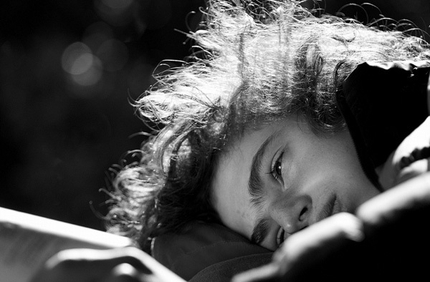



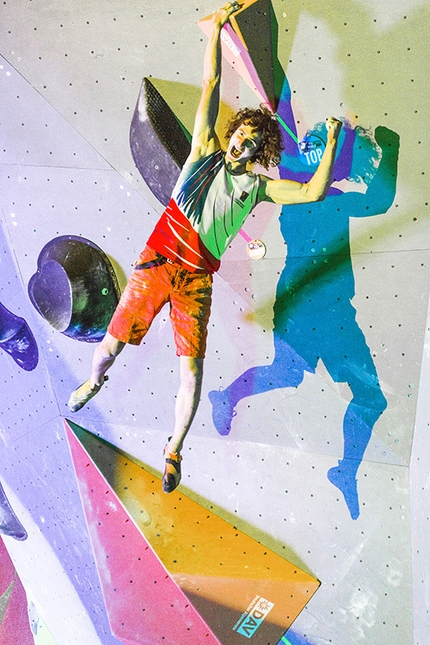




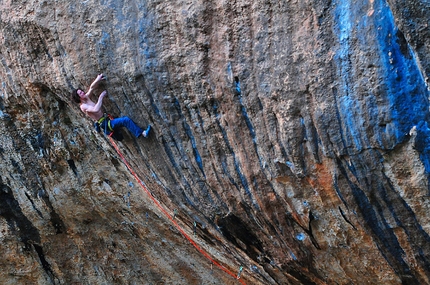


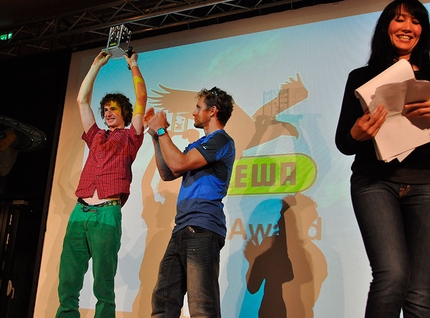

 See all photos
See all photos



















